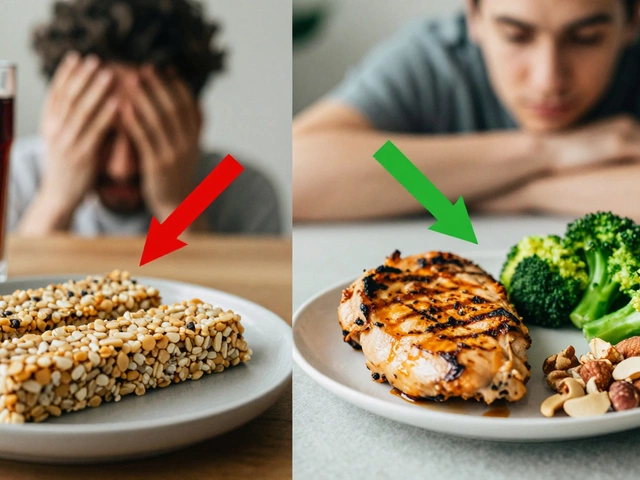Trying to lose 20 pounds in a single month sounds exciting—maybe even a little wild. So, can semaglutide actually deliver those kinds of results, or is it mostly hype? If you’ve seen all the before-after pics or heard coworkers talk about their "Ozempic journey," you’re probably wondering if it’s the real deal or just another flash-in-the-pan weight loss trend.
First things first, semaglutide isn’t magic. It’s not a skinny-in-a-bottle pill. It actually mimics a hormone called GLP-1, which helps regulate blood sugar and makes you feel full faster. That means you naturally eat less and, over time, lose weight. It was originally used for type 2 diabetes, but doctors noticed patients kept dropping pounds—so, now it’s a big name in weight loss clinics and even online pharmacies.
But can it really help you lose 20 pounds in 30 days? There’s a lot of buzz, but it’s not as simple as just getting a prescription and watching the scale nosedive. Safety matters. I’ve watched my friend, Neil, try it. He dropped fat pretty quickly at first, but there were days he felt wiped out, and his appetite was nearly gone—almost to the point where even pizza couldn’t tempt him. That’s a red flag if you like food as much as I do!
If you’re tempted to chase a big, fast number, you’ve got to think about the bigger picture – like what happens to your body, your mood, or your energy when you speed through weight loss. And if you’re eyeing an online pharmacy to skip the doctor’s office, there are some solid dos and don’ts to keep in mind.
- How Semaglutide Actually Works
- Is 20 Pounds in a Month Realistic?
- Doctor Advice and Health Risks
- Tips for Safe and Sustainable Weight Loss
- Buying Semaglutide Safely from Online Pharmacies
How Semaglutide Actually Works
Semaglutide is a prescription medication that started out for treating type 2 diabetes. Later, folks started noticing it also helped them shed pounds. What’s the big deal? Semaglutide acts kind of like a hormone in your gut called GLP-1. When you take it, your brain thinks you’re full faster, so you just don’t want to eat as much. With less munching, you start dropping weight.
This isn’t just a guess. A lot of research points out how it works in real people, not just lab rats. When semaglutide is in your system, it slows down how quickly food leaves your stomach. That means you feel full even longer. It also tells your pancreas to release insulin (which helps keep your blood sugar in check) and drops the amount of another hormone, glucagon, which can spike your blood sugar. Here’s how it usually plays out in your body:
- It makes you feel full sooner and for longer periods.
- You naturally eat smaller meals, without feeling like you’re starving.
- Your blood sugar stays steadier and you avoid those wild energy swings.
Because you’re naturally eating less, you start losing weight. But how much? A study from 2022 in weight loss clinics found that people using semaglutide lost about 15% of their body weight in just over a year (that’s a big deal if you weigh 200 lbs—that’s 30 pounds). But keep in mind, those folks stuck with the medicine and followed a healthier diet.
| Effect | How Semaglutide Helps |
|---|---|
| Appetite | Reduces hunger and cravings |
| Blood Sugar | Stabilizes glucose levels after meals |
| Digestion | Slows stomach emptying, keeps you feeling full |
Most people inject semaglutide once a week. It’s not the kind of thing you pop like a daily pill, and you use a thin needle under the skin—usually in your belly, thigh, or upper arm.
One thing to remember: just taking the medication doesn’t mean you can skip healthy habits. The best results show up when semaglutide is used together with a low-calorie diet and a bit more movement. So, it helps, but it’s not a free pass to eat fast food all week!
Is 20 Pounds in a Month Realistic?
Losing 20 pounds in a month with semaglutide might grab attention, but it isn't something most doctors would pitch as a safe target. In big clinical trials—like the STEP studies, which got semaglutide its FDA approval for weight loss—the average person lost about 12–15% of their body weight but over a year, not just 30 days. That equals maybe 2–4 pounds a month for most folks who stick with it and tweak their diet and habits too.
Trying to drop weight this fast can put a strain on your body. Even Weight Watchers and other popular plans suggest aiming for one or two pounds per week. Health pros say losing weight any faster usually means you’re shredding not just fat, but muscle and water too. That can leave you tired, cranky, and more likely to regain what you lost.
Some people using semaglutide report big changes right away, especially if they start at a higher weight or make major changes to their eating. But hitting the 20-pound mark in 30 days? That’s rare and risky. Rapid loss can bring side effects like constant nausea, vomiting, even dehydration. Not the best trade-off just to see the numbers drop fast.
If the scale moves fast early on—maybe in the first two weeks—it’s often just water weight leaving your body as your eating habits change. That can be motivating, but real fat loss takes longer. And once your body adapts to the medication, weight loss usually slows to a steadier, more manageable pace.
Bottom line: 20 pounds in one month isn’t impossible for everyone, but it’s not typical, it’s not recommended, and chasing that number can do more harm than good. If you’re thinking about semaglutide, set real expectations and focus on safe, consistent progress instead of speed.

Doctor Advice and Health Risks
If you tell your doctor you want to lose 20 pounds in a month, especially on semaglutide, there’s a good chance they’ll hit the brakes. The CDC and most experts say that 1–2 pounds per week (so, 4–8 pounds a month) is the safer, more realistic target. 20 pounds? That’s pushing it and could mess with your health.
Semaglutide might sound like a weight loss shortcut, but it does come with risks. When you lose weight too fast, you aren’t just losing fat. Your body could lose water and muscle too. Some common side effects with semaglutide include:
- Nausea and vomiting
- Diarrhea or constipation
- Stomach pain
- Feeling tired or weak
But that’s not all. The FDA has flagged more serious side effects too, like pancreatitis (your pancreas gets inflamed), gallbladder problems, or changes in vision. A tiny group may also experience thyroid tumors—this is why your doctor will ask if you or anyone in your family has had thyroid cancer.
Here’s a quick breakdown of what researchers have seen in studies:
| Side Effect | How Common (%) |
|---|---|
| Nausea | 44 |
| Diarrhea | 30 |
| Vomiting | 24 |
| Constipation | 24 |
| Serious (like pancreatitis) | <1 |
Doctors also watch for dehydration. All those trips to the bathroom from diarrhea or throwing up can sneakily dry you out, which tanks your energy and can even mess with your heart or kidneys. If you ever feel dizzy, super weak, or can’t keep food down, that’s an urgent sign to call your doctor or even go to the ER.
Another thing: If you already take meds for diabetes or blood pressure, semaglutide can change how your other drugs work. So mixing meds without a doctor watching out for interactions is risky business.
If you’re thinking about online pharmacies, you still have to be careful—get a prescription, and make sure there’s actual medical guidance. End of the day, weight loss that sticks comes down to slow and steady changes, not shortcuts that leave you feeling like you just got off a rollercoaster. Always let your doctor know what you’re planning, even if the internet says otherwise.
Tips for Safe and Sustainable Weight Loss
Trying to lose a lot of weight quickly can mess with your body and isn’t great for keeping the weight off. Studies from places like the Mayo Clinic say a safe rate is about 1-2 pounds per week, not 20 pounds in a month. Here’s what actually makes sense if you want to use semaglutide or just shed pounds the right way.
- Eat More Protein and Fiber: Both keep you full, which is why semaglutide works so well for some. Aim to have some lean protein and veggies with every meal. Eggs for breakfast, chicken for lunch, beans or tofu for dinner—the basics work.
- Move a Little More: You don’t have to sign up for a marathon. Try brisk walks with Bruno, or ride a bike. Even 20-30 minutes makes a difference if you do it most days.
- Watch the Portions: People underestimate how much they eat. Using a smaller plate and eating slower helps. Mira always says: if you’re reaching for seconds, take a break and see if you’re actually full.
- Track Your Progress: Apps make it simple to track food and activity. Even writing things on a sticky note can help you spot patterns and habits.
- Hydrate Smart: Sometimes you’re just thirsty, not hungry. Keep a water bottle nearby and aim for 6-8 glasses a day. Throw in some lemon if plain water bores you.
If you’re on semaglutide, side effects like nausea or low energy can pop up, especially early on. Listen to your body, and don’t force yourself to eat less than your daily needs. If you start feeling weak, dizzy, or have belly pain that won’t quit, reach out to your doctor fast.
| Method | Average Pounds Lost |
|---|---|
| Semaglutide (clinical dose) | 12-15 lbs |
| Calorie tracking + daily walks | 8-10 lbs |
| Crash diets (not recommended) | 15+ lbs (often regained) |
Crash diets look tempting but rarely last, and most people gain the weight right back. If your goal is to lose the weight and keep it off, stick with real food, keep moving, and use support from friends or a pro when you need it. There isn’t a trick—just steady, smart choices over time.

Buying Semaglutide Safely from Online Pharmacies
Ordering semaglutide online can feel super convenient, but you’ve got to watch out for scams and risky sellers. The FDA keeps warning people about fake or tainted weight loss meds showing up online, especially with stuff as popular as semaglutide. So how do you avoid getting burned?
Your first step is easy: stick with licensed, verified online pharmacies. In the US, you can check sites on the NABP VIPPS database, which lists trustworthy pharmacies. Look for a real address and an on-call pharmacist. Run from any site that won’t ask for a real prescription.
- Never buy from sites offering semaglutide without a doctor’s note — that’s illegal and dangerous.
- Avoid sellers that hide their contact info, invent reviews, or offer "too good to be true" prices. If they’re dirt cheap, something’s off.
- Always double-check that the medicine comes in sealed, original packaging from the maker (Novo Nordisk for Ozempic or Wegovy).
- Watch out for “compounded semaglutide.” Most experts suggest sticking with the real product, since some compounds don’t actually contain the real, active ingredient.
Getting the best price does matter, but safety comes first. Here’s a quick look at the difference between buying from a verified vs. sketchy online source:
| Verified Pharmacy | Unverified Seller | |
|---|---|---|
| Requires Prescription | Yes | No (Big red flag) |
| Authentic Packaging | Yes | Often missing or altered |
| Access to a Pharmacist | Yes | No |
| Legal Protection | Yes | No |
One more thing — legit pharmacies will always put your health first, not just take your money. If you’re in doubt, send them a question. If you get a doctored answer or pushy sales tactics, it’s a sign to move on.
Buying semaglutide safely online comes down to common sense and a little homework. Plenty of people have lost money—and even gotten fake drugs—by ignoring the warning signs. Play it smart, check those boxes, and you’ll avoid the worst-case scenarios.





